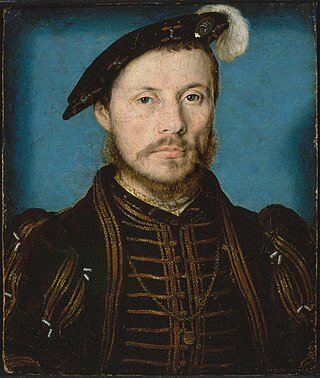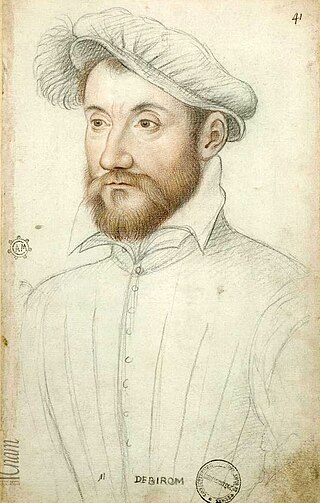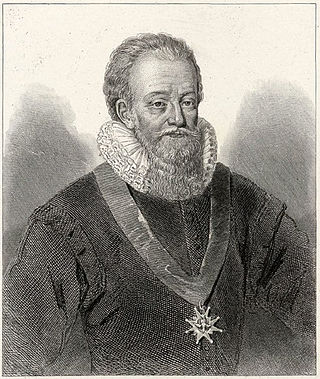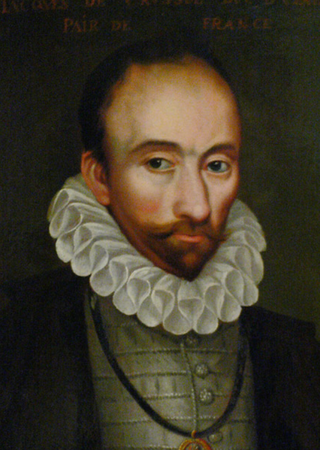
Gaspard de Coligny, seigneur de Châtillon, was a French nobleman, Admiral of France, and Huguenot leader during the French Wars of Religion. He served under kings Francis I and Henry II during the Italian Wars, attaining great prominence both due to his military skill and his relationship with his uncle, the king's favourite Anne de Montmorency. During the reign of Francis II he converted to Protestantism, becoming a leading noble advocate for the Reformation during the early reign of Charles IX.

Anne de Montmorency, duc de Montmorency was a French noble, governor, royal favourite and Constable of France during the mid to late Italian Wars and early French Wars of Religion. He served under five French kings. He began his career in the latter Italian Wars of Louis XII, seeing service at Ravenna. When François, his childhood friend, ascended to the throne in 1515 he advanced as governor of the Bastille and Novara, then in 1522 was made a Marshal of France. He fought at the French defeat at La Bicocca in that year, and after assisting in rebuffing the invasion of Constable Bourbon he was captured at the disastrous Battle of Pavia. Quickly freed he worked to free first the king and then the king's sons. In 1526 he was made Grand Maître (Grandmaster), granting him authority over the kings household, he was also made governor of Languedoc. He aided in the marriage negotiations for the king's son the duc d'Orléans to Catherine de Medici in 1533. In the mid 1530s he found himself opposed to the war party at court led by Admiral Chabot and therefore retired. He returned to the fore after the Holy Roman Emperor invaded Provence, leading the royal effort that foiled his invasion, and leading the counter-attack. In 1538 he was rewarded by being made Constable of France, this made him the supreme authority over the French military. For the next two years he led the efforts to secure Milano for France through negotiation with the Emperor, however this proved a failure and Montmorency was disgraced, retiring from court in 1541.

Armand de Gontaut, Baron of Biron was a soldier, diplomat and Marshal of France. Beginning his service during the Italian Wars, Biron served in Italy under Marshal Brissac and Guise in 1557 before rising to command his own cavalry regiment. Returning to France with the Peace of Cateau-Cambresis he took up his duties in Guyenne, where he observed the deteriorating religious situation that was soon to devolve into the French Wars of Religion. He fought at the Battle of Dreux in the first civil war. In the peace that followed he attempted to enforce the terms on the rebellious governorship of Provence.

Jacques de Savoie, duc de Nemours was a French military commander, governor and Prince Étranger. Having inherited his titles at a young age, Nemours fought for king Henri II during the latter Italian Wars, seeing action at the siege of Metz and the stunning victories of Renty and Calais in 1554 and 1558. Already a commander of French infantry, he received promotion to commander of the light cavalry after the capture of Calais in 1558. A year prior he had accompanied François, Duke of Guise on his entry into Italy, as much for the purpose of campaigning as to escape the king's cousin Antoine of Navarre who was threatening to kill him for his extra-marital pursuit of Navarre's cousin.

The County of Geneva, largely corresponding to the later Genevois province, originated in the tenth century, in the Burgundian Kingdom of Arles (Arelat) which fell to the Holy Roman Empire in 1032.

Gaspard de Saulx, sieur de Tavannes was a French Roman Catholic military leader during the Italian Wars and the French Wars of Religion. He served under four kings during his career, participating in the Siege of Calais (1558) and leading the royal army to victory in the third civil war at the Jarnac and Moncontour. A strong Catholic, he founded the confraternity of the holy ghost in 1567 which would be a template for other militant Catholic organisations across France. He died in 1573, shortly after the opening assassinations of the Massacre of Saint Bartholomew, which he had helped plan.

The Battle of Moncontour occurred on 3 October 1569 between the Royalist Catholic forces of King Charles IX of France, commanded by Henry, Duke of Anjou, and the Huguenots commanded by Gaspard de Coligny.

Albert de Gondi, duc de Retz seigneur du Perron, comte, then marquis de Belle-Isle (1573), duc de Retz, was a marshal of France and a member of the Gondi family. Beginning his career during the Italian Wars he fought at the Battle of Renty in 1554, and in many of the campaigns into Italy in the following years, before returning to France for the disastrous battle of Saint-Quentin and battle of Gravelines both of which saw the French army savaged.
René of Savoy was a French nobleman and soldier. He was count of Villars (1497) and of Tende (1501). Known as "the Great Bastard of Savoy", he was the illegitimate son of Philip II, Duke of Savoy and Libera Portoneri - this made him the originator of the Savoie-Villars branch of the House of Savoy.

Anne Lascaris, countess of Tende and of Villars, was a French noblewoman. She was the daughter of Jean-Antoine II de Lascaris, comte de Tende and Ventimiglia, lord of Mentone, and his wife Isabeau d'Anglure-Estoges.
Jacqueline de Montbel d'Entremont was a French courtier, possible artistic muse and Huguenot, known for her experiences during the French wars of religion. After her first husband's death, she converted to Protestantism and married Gaspard II de Coligny, who was later killed in the St. Bartholomew's Day Massacre.

Madeleine of Savoy (1510–1586) was a French court official, Première dame d'honneur to the queen of France, Elisabeth of Austria, from 1570 until 1574.

Charles de Montmorency, Duke of Damville was a French aristocrat, military commander, rebel and Admiral during the French Wars of Religion. Damville was the son of Anne de Montmorency, chief favourite of Henri II and Madeleine of Savoy granting him a central place in French politics. As a result in 1562 he was elevated as lieutenant-general of the Île de France, serving under his elder brother François de Montmorency. In 1567, with the establishment of the king's brother Anjou as lieutenant-general of the French army, Méru joined his council to advise him on political matters. Méru participated in the siege of La Rochelle in 1573 under the direction of Anjou. Around this time he developed a proximity to the younger brother of the king Alençon.

Honorat I de Savoie, seigneur de Sommerive (1538–1572) was a governor and soldier during the French Wars of Religion. He entered high office as lieutenant-general of Provence, appointed in 1562, serving under his father. He would take the opportunity civil war presented to usurp the authority of his father, and drive him into exile, temporarily claiming the title of governor for himself, before relinquishing it during peace. He fought for the crown loyally after this, aiding in the campaign against the viscounts of Languedoc in both the second and third civil war. His father died in 1566 and he inherited his titles despite his earlier rebellion. The crown would award him his father's office of governor of Provence shortly thereafter. He died on 8 October 1572.

Claude de Savoie (1507–1566) was a French governor and commander. Son of René of Savoy, Tende's career would begin at a young age, fighting at the Battle of Pavia in 1525. He served extensively throughout the later Italian Wars in particular holding a key role in the Italian War of 1536–1538 and the dauphins invasion of Roussillon. During this time he would establish himself as a moderate religious presence, keen to achieve compromise and avoid the brutality that typified the Massacre of Mérindol perpetrated by one of his subordinates in 1545. With the outbreak of civil war in 1562, his son Sommerive rallied the Catholics of Provence against him, and successfully drove him into exile. Restored to his office in 1563, he would lead the region for another 3 years before dying in 1566.

Jacques de Crussol, 2nd Duke of Uzès (1540-1584) was a Protestant, then Catholic military commander and duke during the French Wars of Religion. Converting to Protestantism early due to the influence of his mother he would be acclaimed as defender of the Protestant church in Languedoc in early 1562. He would conduct a brutal campaign during the first civil war, capturing several towns and massacring their garrisons.

Guy de Daillon, comte du Lude was a French governor and military commander during the French Wars of Religion. The son of Jean de Daillon, governor of Poitou from 1543 to 1557, Lude inherited his position in the province, becoming governor shortly after his father's death. In 1560 the province, which had been a subsidiary governorship under the governorship of Guyenne was reconfigured to an autonomous entity, and given to Antoine of Navarre to buy his loyalty to the Guise regime. Resultingly Lude was given the role of lieutenant-general of the province instead of governor. However this was functionally a promotion as, when governor of Poitou previously he was subordinate to Navarre's authority in Guyenne. Now when Navarre was absent he had the powers of an autonomous governor.















